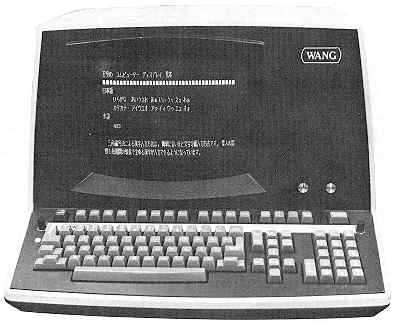COMPUTER AGE
by.Alexander Besher

One of the most successful firms owned by Oversease Chinese,
U.S.-based Wang has pioneered automated translation from
English to Chinese ideograms.
San Francisco writer Alexander Besher is a creative consultant to the computer industry through his firm Compatible Communications. He was born in China, raised in Japan and introduced to personal computers in California.
After five centuries of deliberately turning its back on technology, the largest nation on earth is playing catch-up with computers. The creators of silk and paper, printing and gunpowder, are taking steps to recast the face of China with the so-called Four Modernizations program. Countering the effects of the Cultural Revolution, when roving hordes of Red Guards busied themselves dismantling China's hightech industries, this program is designed to leap-frog the entire country into the information age.
The China Road
In the West, the computer is regarded as a labor-saving device. In China, where the one billion population is growing by seventeen million each year, saving on ten-cent-an-hour labor is hardly a paramount consideration. Rather, it is in the realm of information and data bases, on-line transaction processing and local area networks that the Chinese are most involved. One major development has been the establishment of a soybean varieties data base system that would provide stable, high-yield soybean strains.
An interesting result of the Four Modernizations plan has been the recent decision of the Committee for Science & Technology to concentrate on the development of microcomputers, to the virtual exclusion of minis and mainframes, for use in regulating freight traffic, forecasting weather, combating plant disease, processing hydrological data and calculating satellite orbits. Micros are also helping in the tabulation of the national census and in petroleum exploration. Also benefiting from computerization are factories, department stores, customs offices, banks, foreign trade, metallurgy, chemistry, light industry, textiles, telecommunications and public health.
More than four thousand computers and seventeen thousand microcomputers were in operation in China at the start of 1983, and estimates for the next decade vary with each fortune cookie cracked open by Western high-tech salesmen. "A microchip for every Chinese" is the battle cry here in the West. Using Western models, the Chinese are developing their own extensive hardware and software, although it seems likely they will continue to import more than they produce themselves in the near future. The Chinese have already developed their own version of the IBM PC, called the Great Wall 100, and they have made the jump from 8-bit to 16-bit systems. Chinese Apple clones are being introduced as city traffic information stations, answering questions about ticket prices, routes, and types and numbers of vehicles to be taken.
A New Perspective
For all her singleminded drive toward total modernization, China is discovering computer applications that are unique to her own ancient civilization. This is particularly true of the field of traditional Chinese medicine, where software is catching up with acupuncture as the preferred technique for treating ailments. The Chinese have a computer system of their own that is capable of diagnosing diseases, offering a course of treatment, then printing the prescriptions and directions for taking medicines. The whole process-including the doctor's interview of the patient, the input into the computer of the description of the patient's symptoms and the automatic output of the prescription in Chinese characters-takes only five to ten minutes.
A patient suffering from a cold, for example, might receive a prescription for a medicine containing:
10% rhinoceros horn
7% pearls
7% bear gall
5% cow bezoar
3% musk
28% rhizoma coptidis
30% fined borax
10% toad cake
7% pearls
7% bear gall
5% cow bezoar
3% musk
28% rhizoma coptidis
30% fined borax
10% toad cake
Although the so-called Pinyin system of romanization has been officially adopted in their written language in order to improve mass communication (e.g., Peking, the capital, is accordingly spelled Beijing), the Chinese have also managed to develop processing systems for the vast number of traditional characters that go back thousands of years to their origins on oracular bones and tortoise shells. The Chinese character disk operating system (CDOS) allows some 8,000 character patterns to be stored on a floppy disk, covering all the 6,763 characters that are fixed in the national code. Pressing various English-letter keys on a regular keyboard while holding an alternate function key makes it possible to re-create the exact strokes (as many as eight per character) that define each Chinese ideogram. Another method of keying in involves a touch-sensitive plastic board that features color-coded sections containing a number of Chinese characters. A character is entered by touching the appropriate spot on the board with a wand.
A typical twelve-inch CRT screen is capable of displaying 512 to 1,024 Chinese characters. The character library, depending on the system, can store, say, 16 x 15 and 14 x 22 dot-matrix types, outputting characters of various sizes. It can also display or print characters horizontally or vertically. Software includes controller, language processor, application programs and Chinese dictionaries.
Efforts are underway to teach computer technology to middle school students, and experimental classes are being set up in various youth centers around the country. Teenage Chinese software geniuses receive their hands-on training while writing programs that help factory workers accomplish in half an hour jobs that would normally require several days. Shanghai is emerging as China's Silicon Valley, with software as its main thrust.
It is likely that just as in the past, when scholars became a power elite, China's new interest in high technology will give rise to a social class of techno-cadres who will move to the top of the nation's power pyramid. China's high-tech prognosis involves long-term speculation rather than forecasting. But one thing is already becoming apparent as this Eastern power gears itself up to the Western challenge: in addition to all the tea in China, there will be a wealth of computer technology.
Return to Table of Contents | Previous Article | Next Article

